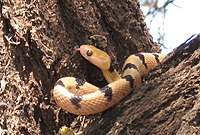Telescopus
| Telescopus | |
|---|---|
 |
|
| T. semiannulatus in an acacia, central Tanzania | |
| Scientific classification | |
| Kingdom: | Animalia |
| Phylum: | Chordata |
| Subphylum: | Vertebrata |
| Class: | Reptilia |
| Order: | Squamata |
| Suborder: | Serpentes |
| Family: | Colubridae |
| Subfamily: | Boiginae / Colubrinae |
| Genus: |
Telescopus Wagler, 1830 |
| Type species | |
|
T. fallax Fleischmann, 1831 |
|
| Synonyms | |
|
|
Telescopus, the Old World catsnakes, is a genus of 12 species of mildly venomous opisthoglyphous snakes in the Colubridae family.
They are found from the Balkans and Pakistan through to southern and western Africa, plus two species in northern Eurasia.
The genus is characterised by having a slender slightly flattened cylindrical body and attaining a total length (including tail) of between 80–180 cm (about 2½-6 feet). They have medium-large eyes with vertical pupils, a typical feature of nocturnal reptiles, and have smooth dorsal scales. The dentition of the genus is as follows; typically 10–12 maxillary teeth, with a space before a pair of grooved fangs at the rear of the mouth, approximately level with the eyes. The anterior mandibular teeth are usually longer than the posterior mandibular teeth, perhaps to aid the arboreal species in catching and holding prey whilst in trees. The species are mostly drab, spotted snakes, but include the spectacular tiger snake (T. semiannulatus), which is orange in color with black saddles along its back.
This genus Telescopus includes both arboreal and terrestrial species, and can be found from sea level up to 2,000 metres (about 6,600 feet) above sea level. They are nocturnal hunting snakes with a distinct head and large eyes.
The primary prey species are small lizards, including geckos, although some members of the genus may occasionally prey on small birds, rodents and amphibians.
All species in the genus are oviparous, laying clutches of 5-15 eggs.
...
Wikipedia
